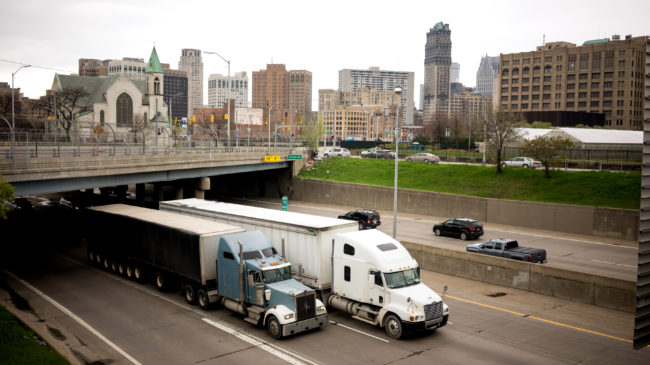With the country dealing with the COVID-19 pandemic, an 11.1 percent national unemployment rate, state and local budgets collapsing, and major protests across the country aimed at bringing about much-needed police and criminal justice reforms, transportation infrastructure is understandably not a top priority for most policymakers today. But maintaining infrastructure is critical to the economy as it tries to emerge from this recession.
Our country’s Interstate highway system, which was mostly constructed in the 1960s and 1970s, is the backbone of our transportation network. While it represents just 2.5 percent of all lane miles in the country, the Interstate highways carry 25 percent of all vehicle traffic. Yet most Interstate highways are in poor condition and need to be reconstructed.
Despite a temporary respite from urban congestion, traffic volumes are increasing as freight travel continues to grow. A recent INRIX survey found that traffic volumes are now back.up to 90 percent of pre-COVID levels and some metropolitan areas are nearing their traffic volumes of a year ago—when the economy was stronger.
At the same time, pavement conditions on highways are deteriorating. Two percent of rural Interstate pavement mileage and five percent of urban Interstate pavement mileage is in poor condition.
A recent Reason Foundation study estimates that modernizing the Interstate system will cost $2 trillion. But current proposals to fund the improvements are inadequate. A federal commission has suggested raising the gas tax to pay for the needed improvements. But, to do that, the federal gas tax increase would need to be raised by 360 percent. It’s impossible to see a gas tax increase of that size passing Congress and being signed by a president. Consider that the 18.4 cents-per-gallon fuel tax has not been raised at all since 1993.
Several states have tried to dedicate small amounts of funding (in some cases $100 million per year) to Interstate upgrades. While better than nothing, using this approach, it would take 50 years just to rebuild the highways that are degraded right now.
State governments are increasingly coming to the realization that the federal government is not coming to the rescue, and their own incremental approaches to infrastructure will not be sufficient in many cases.
States own their portions of the Interstate system. Their economies rely on these highways. And cities and states don’t have the luxury of waiting decades for federal lawmakers to piecemeal together minor fixes.
One promising solution is tolling. My colleague Bob Poole’s Interstate 2.0 study found that implementing a tolling system based on 3.5 cents-per-mile for cars and 14 cents-per-mile for trucks, indexed annually for inflation. would generate revenue to cover 99 percent of the net present value of the costs of rebuilding the Interstate system. This makes tolling a feasible option nationwide.
To make sure that tolling doesn’t turn into a cash cow, we recommend states adopt six customer-friendly tolling provisions.
First, tolls must be collected electronically and charged per mile.
Second, tolls need to replace, not supplement, today’s fuel taxes.
Third, money generated from tolls can only be used to pay for for the capital, operating, and maintenance costs of the Interstate System.
Fourth, tolls can be charged on Interstates only after that segment of the highway has been reconstructed or replaced.
Fifth, tolls must apply to all vehicles, including electric vehicles.
Finally, sixth, the toll rates charged must be the same for in- and out-of-state vehicles.
Thankfully, some states are examining and adopting this Interstate 2.0 approach to tolling.
The Michigan legislature recently passed Senate Bill 517, which requires the state “to conduct a feasibility study and strategic implementation plan on tolling highways of this state, including revenue projections based on an analysis of optimal tolling rates, vehicle counts and types by state of registration, and traffic diversion.”
One key value of the study is that it will take a comprehensive look at the entire state, not merely one corridor or one metro area in Michigan. Developing a connected, tolled network of highways that offer congestion-free travel on well-maintained pavement could be a game-changer for Michigan and its economy.
But before developing and implementing such a comprehensive long-term solution, the Michigan Department of Transportation needs to examine traffic diversion and roadway design options for its corridors. Further, policymakers will need to understand how tolling may change local and regional travel patterns and economic development.
Michigan is not the first state to study this type of tolling. Oregon and Washington created commissions to examine potential revenue sources and options for their roads. Indiana has conducted two separate studies examining the feasibility and then the implementation of tolling its highways.
But, in some ways, Michigan may be the most important state to take this step thus far. Michigan has 10 million people, an economy at risk of suffering long-term consequences from the pandemic and recession, and it needs to address its poor highway pavement conditions to help improve mobility and economic activity. The Michigan legislature’s move to study the feasibility of tolling is a great start and should lead it to develop sustainable funding streams for the highway infrastructure the state needs. It may also serve as a model for other states looking to repair and enhance their own Interstate highway networks.
For more information, listen to Baruch Feigenbaum discuss the law and tolling study on the Michigan DOT’s “Talking Michigan Transportation Podcast.”

